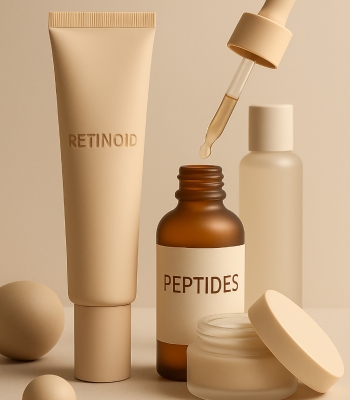Skincare That Works While You Sleep.
According to the all-important jargon: one cannot remove the traces that show one has lived. It is not fighting against aging as if it were a defect; it is merely providing the skin with whatever it needs as the passage of time goes by.
Of course, the anti-aging routine should not be too long or complicated; it should just make sense. Your skin does a lot while you sleep: repairing itself, rebuilding, calming itself from the day’s stresses. Supporting it in any way really counts.
Here is how you go about establishing an anti-aging night routine that feels doable, comforting, and helpful to any age and skin type:
Step 1 – Take the Day Off
Before anything else, just breathe for your skin. Dirt and sweat, makeup, and sunscreen-have to go.
Use something gentle. An oil-based cleanser or micellar water works well to break down makeup and SPF. No need to scrub like you’re cleaning a pan. Just massage it in, rinse, and if your skin feels like it, go in with a second cleanser.
If your face feels soft and clean, but not tight or squeaky, you’re on the right track.
Step 2 – Treat What’s Changing

This is where you can really help your skin do its job. At night, your face isn’t battling UV rays, sweat, or city air. It’s the perfect time for active ingredients to do their quiet work.
Retinoids (or Retinol)
Retinoids are probably the most talked-about ingredient when it comes to aging skin. And for good reason. They help with fine lines, breakouts, texture, uneven tone – all of it.
If you’re new to them, start slow. Two nights a week, then increase gradually. A pea-sized amount is enough for your whole face. Really.
Don’t expect overnight magic. It takes time. But the long-term payoff is solid.
Peptides
If the skin does not like retinoids, try peptides instead. Hence, the peptides work to support collagen and maintain elasticity. You would commonly find them in serums or creams prioritizing firming or replenishing.
Look for copper peptides or ones that are called signal peptides. They tend to be mild and compatible with most skin types.
Step 3 – Hydrate and Seal Everything In
Your skin loses moisture at night. This is just how it is. Or in other words, your job is to give what it needs while helping it hold on.
Night creams tend to be a little bit heavier. Therefore, that’s absolutely fine: you won’t be putting anything on top of it.
Good ingredients to check out include:
- Glycerin or hyaluronic acid for hydration
- Ceramides or squalane for barrier repair
- Niacinamide in case your tone is uneven or your skin needs calming
Apply your moisturizer after your serum or treatment. Your skin will tell you whether or not it is enough.
Step 4 – This one need attention for eyes and lips, too
This skin under the eyes is thinner and first to show signs of age. A special product is not necessary, although a product may be used if he or she chooses to.
Caffeine is an anti-puffiness remedy. Peptides and mild retinoids treat the fine lines. That which your skin calls for is the correct choice.
And your lips? They should receive more than just a rushed swipe of lip balm. Use something thick and heavy before bed. Shea butter, lanolin, or ceramides prevent chapping and dryness.
Optional Step – Add a Boost When You Feel Like It
You don’t have to do this every night. But some evenings your skin might ask for more.
Overnight masks or a couple of drops of facial oil will help your skin feel more nourished by morning. Rosehip, marula, or jojoba oils? Yes, please! Just please don’t go heavy; your pillowcase will not thank you.
These extras should feel like a treat. Not an obligation.
What to Skip at Night – Some Things Just Get in the Way
It is not the best option to exfoliate daily. Or be using three acids in one routine. Less can almost always be more.
Things to avoid:
- If harsh scrubs act in a phsyicall abrasive way
- Fragrance-heavy products (this constricts especially if your skin is sensitive)
- Mixing retinoids with strong acids unless you know what you are doing
Listen. If it stings, it causes redness the next day, or makes your skin flake in weird patches-drop it. Your routine should be helping you, not stressing you out.
Does the Program Change for Aging?
Yes. But Not As Much As You Would Think.
A few basics remain constant. Cleaning. Treating. Hydrating. What does change is somehow surrounding the way your skin reacts.
Late twenties-go on good habits, use retinol slowly, apply sunscreen every day but never forget it actually needs hydration from time to time.
In late thirties and early forties-one is concerned about texture, firmness, and maintaining a good skin barrier. Richer cream may be needed and longer recovery time from active ingredients.
Fifty-sixty ish, your face may feel drier or thinner. So, the usual approach means a gentle-looking version of what you have been using. But no, you don’t need a set of scalping ten new products just because you have a milestone birthday.
Final Thought
Make It Yours.
Care for Yourself.
It is not about doing everything nicely or having 20 products in your cabinet. Nighttime skincare is an act of kindness for yourself. Not a chore.
Start with however many steps you can manage tonight; three steps will do.
Clean your skin. Apply treatment. Apply moisturizer. That is a routine.
What is important is showing up for yourself and consistency in doing so. Working with your skin instead of fighting it.
It belongs to a short time of quiet, maybe ten minutes. The rest is for sleeping. And that is where the real magic happens.
